If there is life in Flint...

There we were in this plain white vehicle truckin’ northbound on the I-69 with oversized Starbucks cups in our hands (unfortunately, without those there would be absolutely no coffee in Indiana, a very sad fact it seems), whizzing past corn fields and Rest Areas and strange taxonomies of roadkill that accumulated every few hundred yards or so on the highway’s shoulders (I’m convinced Indiana has more roadkill than any other state in the U.S. – after forcing Wes to open his eyes while driving we spotted three mangled little corpses blur past us in a single second followed immediately by a broken down Oldsmobile, the perfect exclamation point to all that ended up there and would never make it across the road), squirrels, raccoons, mice, gophers, rabbits, cats, drivers (who knows what else) … the road to Flint was already a stroll through a long cemetery.
When Wes, Nihal, and I headed up there a few weeks ago I couldn’t wait to pick up on that geography of urban ruins that weaves so many of my interests together about architecture, global economies, lost histories, indigenous culture, systemic poverty, the road trip, contexts of abandonment, informal communities, urban salvagers, and so on.
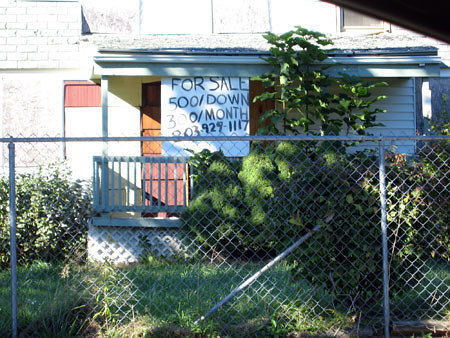
As you know, Wes has been paying close attention to Flint over the last couple of years, he says he’s photographed literally thousands of abandoned houses there, some that have just remained boarded up for years, others that have been tagged with For Sale signs from hustlers trying to collect money on structures they don’t even own. Still, some homes are being moved into by neighbors looking to upgrade next door just as the occupants have left the property. There are owners who are defiant, scared, territorial, proud, some who want to keep their homes and those who pray for demolition, and in many ways Flint is just another shade of New Orleans caught in between states of devastation and piddly renewal. Though instead of having been flooded, it’s all dried up instead.
Like I said, the highway out of Indianapolis towards Flint, which you basically take all the way, is like a migration killzone; a fatal border fence for rodents and transients of all kinds. It was a little creepy heading up towards one of the nation’s most notorious urban voids with dead animals spread all over the road along the way. There was this dingy suggestion of an ongoing mass exodus from Flint where life is regularly forced to flee but unable to get far before meeting a collective nomadic tragedy piled together a couple hundred miles down the main highway. I wondered how often these carcasses were hauled off - had they been left for weeks or were they really stacking up that quickly?
Nevermind. We swilled our white chocolate lattes and tried to hold them in our bladders until the next John on down the way.
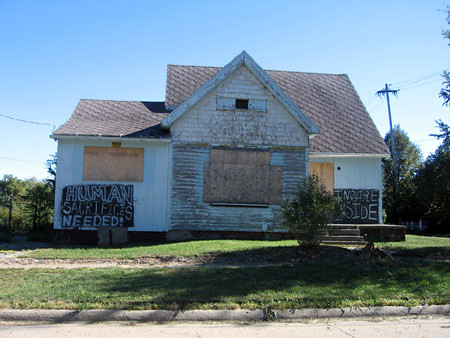
On the road we all got to talking and Nihal Perera, an urban planning professor at Ball State (and an all around great guy whom you will get to know more in the future) told us a little about his research into the “tiger landscape” and how various spaces of civil war have been distributed in Sri Lanka, his native country. Fascinating stuff: the ways that landscape incorporates separatism and civilian forms of bordering and occupation. He is also examining how Asian cities are undergoing their own distinct patterns of urbanization challenging the notion that American urbanism is taking over the global landscape, all of which we will be hearing more about in days to come, as well. But it made for a crazy overlay en route to our encounter with Flint.
Of course, the question on everyone's mind that afternoon was how do you treat a landscape that suffers from so much urban evaporation? What are the psychological and cultural sensitivities of addressing wholesale abandonment this way? How do we even begin to look at such a place, or know that we are even really seeing it for what it is beyond the hollowness of its remains?
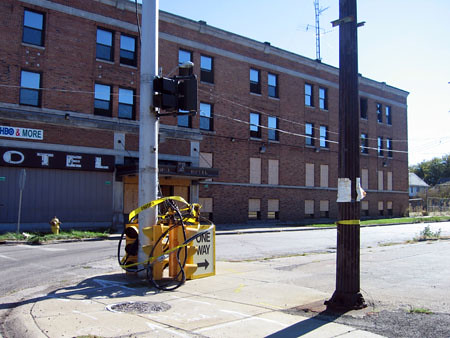
In a report Wes produced on the topic called Deconstructing Flint (which he presented at Postopolis!) specifically looking at the ways architects might proceed with a more humane / conscious/ and ecological strategy of demolition, in his estimate "the story of Flint’s decline is rather simple." He noted that in the time General Motors operated in Flint from early in the twentieth century, "the company’s ascent drove the worker-citizens to unparalleled personal, familial, and communal gains." Job production skyrocketed after World Wars I/II with enormous increases in automobile demand. "At its peak in the 1960s," he told me, "Flint was home to 190,000 persons and 80,000 General Motors’ jobs, and was believed to be on its way to a population of 250,000. Today, Flint’s population is at 120,000," he said. Half of its hopeful estimate. Today close to 17,000 GM jobs remain, though plants are closing left and right. "No one is sure if the bottom has been reached or if it is even in sight."
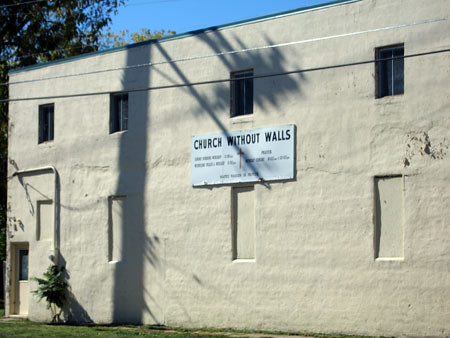
As we got closer Wes filled us in on a buddy of his we were hoping to meet up with once we got there. If there is life left in Flint, Wes told us, then Brian Willingham is it. Our plan was to drive around and take in the sheer vastness of the abandoned neighborhoods, the gridded emptiness, to see firsthand the stretches of serial depression, the gradual stages of decay that began as early as the fifties. I wondered, could we somehow measure the psychological ramifications by driving round and round the city's dying blocks, and past the GM plants that have mostly long been closed (but not as dead as you might think)? Basically, I just wanted to cruise and experience the vacuous heart valves and caved in lung scapes of the old industrial engine that once kept the shrinking city of Flint breathing strong.
And so, that’s just what we would do – roll around and soak in the place whilst trying not to be too blatantly obvious with our BSU marked sedan and our pocket sized cameras looking like suspicious developers or snoopy city officials busy plotting and re-planning the fates of the locals’ lives right under their noses.
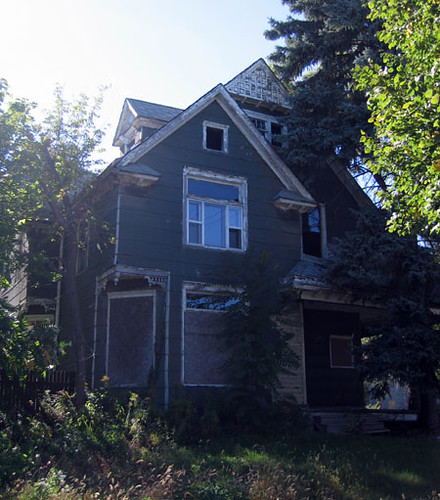
Beforehand I gandered at some of Wes' research just to give myself a better sense of what to expect. Having read from his report in the car, I'll relay this:
Many, if not most, of the houses being demolished and in need of demolition were constructed using low quality materials and techniques. According to Beckley, following WWI and WWII, “small poorly constructed housing was quickly erected on narrow lots, close to the factories that provided employment.” These never were high quality houses. It can be argued that these buildings, long ago, fulfilled their original mission.
Hard, comprehensive numbers are difficult to establish due to the number of actors involved, the time that has passed, and the daunting work that lies ahead. A mayoral aide in Flint stated in late 2006 that City crews tear down two to seven houses every working day. A City of Flint demolition crew chief told me that 4,000 houses need to be torn down “today” and another 10,000 will need to be torn down in the future.
Quantity of demolition waste produced in Flint is significant: 200 cubic yards of waste/house x 5 houses/day (+/-) x 5 work days/week x 52 weeks = 260,000 cubic yards/year. That’s equivalent to a standard city block in Manhattan covered with a block of house debris the height of a 3-story building, or a 15-story building the size of an American football field. Every year.
The number of houses and other properties that are or will be in need of demolition in coming years is staggering. Again, it has been said that 4,000 houses are in need of immediate demolition. One can imagine that 10,000 buildings will need to be torn down in coming years. At the rate of 2-7 teardowns/day, 5 days/week, that’s approximately 1,300/year, or enough houses to keep crews busy for the next 3 years. Plus many hundreds if not thousands more are likely to be abandoned and boarded in coming years.
It should be remembered that the Land Bank pays between $6,000 and $9,000 to tear down and haul away a house.
It's one thing to read these numbers and to try and envision their architectural translation. But, it is another thing altogether to actually see these stats as they are represented physically, as they are naturally positioned in their origins of meaning - these places of urban death.
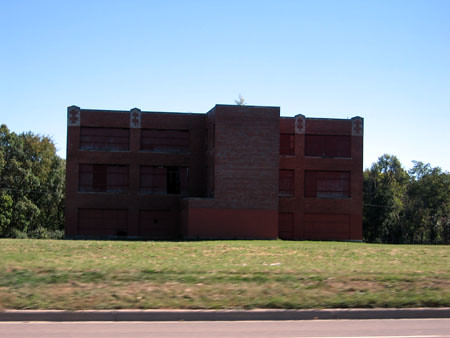
Once we got there we found some grub and planned on trying to meet up with Brian at the Brown Sugar Café later that afternoon, a new spot enjoying a little success from the recent inner core of urban investment that is beginning to take place near the university area downtown, while however further severing the outer districts from progress, into what Brian would later allude to as “The Two Flints of Michigan.”
With a hot corned beef sandwich stuffed in my belly we spent hours slowly ambling past old elementary schools that looked like they’d been closed for years (but also as if they had the money they could be re-opened and suddenly re-populated in a second). Strange, really. It’s quite startling to see places persisting in this kind of semi-abandoned shuttered state of urban limbomania – seeing spaces as essentially helpless.
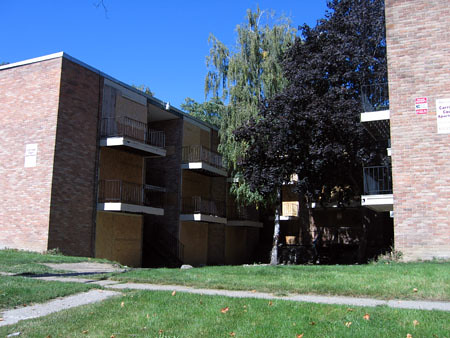
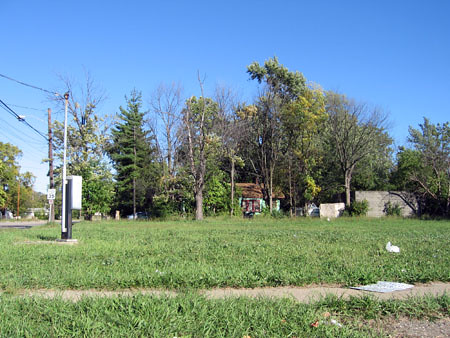
Flint is covered in parking lots and sidewalks with public phone booths hollowed and conquered by wild grass and weeds. Apartment complexes look like they actually vacillate from day-to-day in and out of being open and closed, by people who have a job one day but not the next. In fact, the whole city has this feeling of living day-to-day, hand-to-mouth, of collectively watching itself house-by-house fall into disrepair; Flint is growing quieter, more sparse, in some ways it looks almost colonial again – like dense homesteads plopped down in the fields. They are historic vintage.
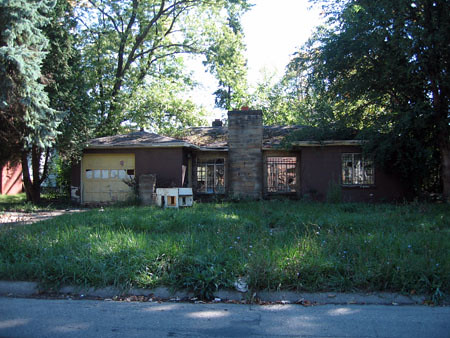
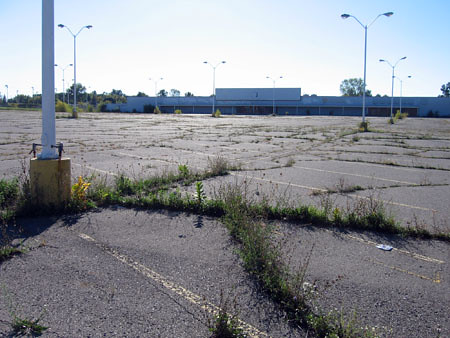
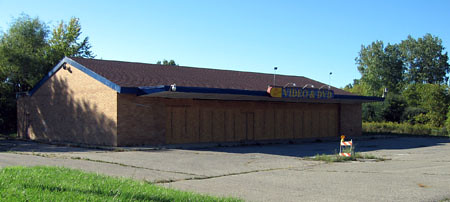
On a larger scale there are entire superstores that have been burnt out from the inside while a nearby video store looks to have just closed (maybe for a portion of the day, or for the winter season alone) and become someone’s home only the day before. Firewood filled the foyers and porch spaces of some houses, tired grandmothers kept refuge in others. Odd piles of collected furniture were pilfered on the corners while teens swept the sidewalks into massive mounds of anonymous memory and debris. Across the street tiny shotgun homes were naked, core structures exposed, picked apart by scrappers with a few occasional shacks in between their lots reduced to massive pits in the ground - their foundations uprooted in a giant scooping instant.
Flint seems like a forgotten graveyard waiting to die even more, as if at any time an army of vulture-like bulldozers might swoop in and demolish everything over the course of a week, before the burial grounds are reseeded and made into grassed over parcels of land ready to be abandoned all over again.
It's a heavy duty place like that. And no matter how much you look at it you never seem to figure out an answer to the plaguing question of what the hell should be done with Flint?
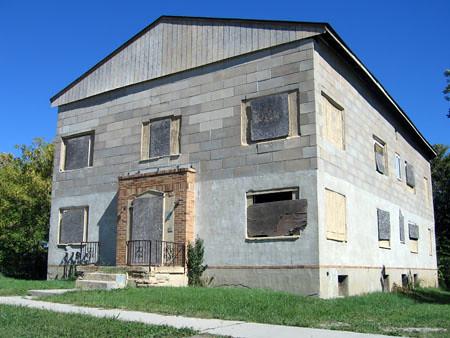
Most houses, however, stand still solid in their construction and become the nightmares of firestarters and angry neighbors instead, they become the haunted playhouses of innocent little children, the nondescript safehouses of heinous criminals and nocturnal ghost dogs, while somewhere out there a lonely shack manages to stash the legacy of some poor unremembered family, until it is discovered, thrashed, knocked down and hauled away in the back of some truck.
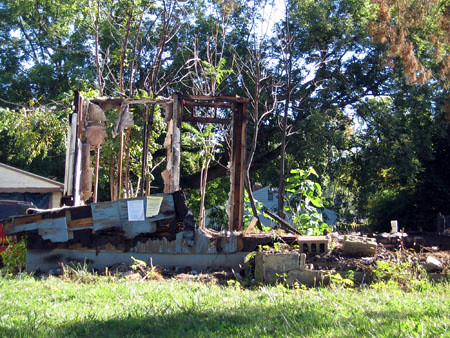
For all that is closed in Flint if there is any one thing you can count on being open, or in abundance even, it is the liquor store sadly enough. And while that alone is not surprising or even unique to Flint, what is unbelievable is the sheer number of liquor stores in a given range of blocks. I try to relate the phenomenon to the number of Starbucks you find in downtown San Francisco in just a couple of blocks. You might think liquor stores were the only things left operating in these parts of the city. Contrasted by all this cloned space of residential nothingness, this was an astounding visceral reality – I wonder, how many lives are completely sustained on a day-to-day basis by the liquor stores? One store we stumbled across was entirely wrapped in heavy duty barbed wire guarded against what I imagine to be thieves who were getting in from the rooftop somehow. But it looked like such a last ditch effort, like everyone and everything was equally desperate.
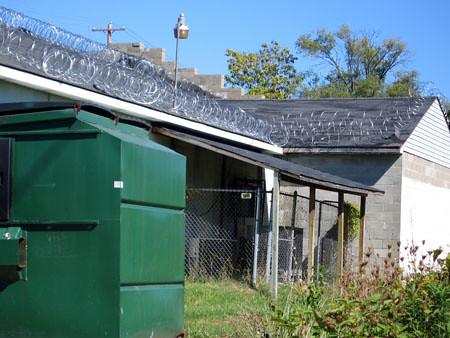
After somehow missing Brian’s call we hung around a bit more at a muscle car show in the little downtown area on S Saginaw St., which is where the Genesee County Land Bank is located as well. Some classic Def Leopard blasted over loudspeakers and reverberated in a very cool way off the surrounding buildings - you could almost hear the vacant dimensions of Flint echoing in the melodies of High 'n Dry and Pyromania. There was a booth that sold iced cold Genuine Drafts in a can, prepackaged sandwiches, antique car calendars, and random auto-fetish crap and memorabilia, messy piles on tables overrun by army recruiter propaganda: posters, pins, photographs of soldiers with their families and platoons, patches, magazines, videos, Army Strong's seductive schmooze. I could probably have stopped there, signed a few papers and been on a plane to Iraq the next day if I wanted to.
Maybe Flint is the fastest way to get to Baghdad these days, I don’t know.
Be that as it may, it was a vital little scene with a couple hundred people bumming around a parking lot to appreciate those sweet gurgling sounds of a guttural muscle cars and all the shine of buffed chrome that goes along with them.
We were just about to bail when Brian suddenly rang us up from around the corner to give word he was getting off work and would meet up. A minute later he raced by in his SUV honking the horn waving as we dashed back to our vehicle and bolted off to (yes, you guessed it) Starbucks, of all places, on the other side of town.
Apparently, Starbucks loves Flint, too, isn’t that nice? I am not sure what it really means that Starbucks is in Flint (let’s face it, they are the new McDonalds!), nevertheless we were soon downing flavored coffees with cream and sugar again like lecherous academic brats from a great corporate boob.
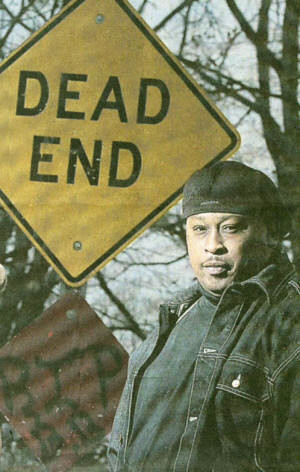
[Image: Brian Willingham as pictured in The Flint Journal, Jan. 11, 2006.]
At first glance Brian Willingham is not anyone you’d want to cross paths with in a dark alley especially in Flint where poverty has soared so high it’s become the third most dangerous city in the U.S. But then again, Brian isn’t your average cop. In fact, he is the first guy you’d want to meet in a dark Flinted alley.
When not out patrolling the surreptitious spaces of his hometown’s ghosted remains that are often used as cover for the worst crimes imaginable, he’s plopped down on the floor in a classroom reading books to school children and charming the teachers, meeting community leaders, parents and bridging that gap with neighborhood groups in areas where the perception of cops can be less than favorable, to say the least.
He’d just come back from a neighborhood where a skinhead rally in a hard black part of town was potentially going to occur and told us thankfully it never happened today. That by itself is crazy to think about. Skinheads still throw rallies? In Flint? Anyway, he could have been anywhere though, combing an abandoned factory, responding to a disturbance in a home with no address; or, he might have just been out photographing his friends in the park, or writing a poem at the Brown Sugar, speaking at the college again reciting a story about his undying pride in Flint. As I later learned he might have been right here at Starbucks half the day for all I knew working on an article for a column the ‘Human Spirit’ he writes in The Flint Journal.
It goes without saying, homie is one thoughtful dude.
Brian recently won a national award from the White House recognizing his work and commitment as a community policeman in Flint (not exactly a place you'd believe was on their map), which actually only says a little about who he is. It just so happens Brian has also published two books and is busy working on his third. Didn’t take more than a few minutes of hearing his story to see why all of the above is so true.
I mean he's no doubt seen some horrendous stuff in Flint, yet all it seemed to do was reinforce his big-hearted family-man spirit, his colossal humility, his knowledge that he is in the beginning and in the end just a man, a father and a son, a human being before anything else.

[Image: Brian Willingham as pictured in The Flint Journal, March 27, 2005 as he reads to a group of Bryant Elementary children during March is Reading month. Willingham said he likes to spend as much time as possible with kids. "They need black male role models," he said.]
But it wasn't necessarily hearing his story so much as how he told it. Perhaps the only thing that overshadowed Brian’s depth of character was his own modesty. There's something unbreakable in his words, dignified in his mellow tone, he made you feel as important as anyone else. I realized there in a jolt of caffeine that it is not just places like Flint that need Brian, but every city really. He was not trying to sell me anything or convince me of police duty or honor. He was just a man there helping me to understand what it is; the Flint I would never see, the Flint that is invisibly real before all our eyes.
He told me how he first got into poetry by writing love letters to his woman from Germany where he was stationed in the army and saw the Berlin Wall fall. As a kid he was fascinated by the work of photographer Gordon Parks, particularly Half Past Autumn and A Choice of Weapons – the notion that a camera or a pen was a black man’s most powerful weapon in America always resonated with Brian even though he would go on to carry a gun for his country and hometown. But, it was the pioneering work of people like Claude Brown’s Manchild in the Promised Land that would guide Brian's own way not only of seeing the city, the urban epidemic for black folks, but of capturing it; of responding to its pain, and understanding how even places like Flint are eternally rehumanized by their struggles.
Only when he lost his job for a summer in Flint and his father passed on did he pick up his camera and shoot the photos you'll find in his first book of poetry Thunder Enlightening; deep personal reflections of life there that mirror a greater landscape of American racism stalking much of Flint’s psyche.
A poem comes to mind:
City Block
Locked in the city block system,
Subdivided on a lot,
Crowded on a porch,
Not far from the sidewalk,
Close to the curb,
Not far from a streetlight on the corner,
Around the block from the store,
On the corner of some street,
Once more.
On a cement lot
Not far from the sidewalk
Close to the curb.
When will I be free from these concrete borders?
- Brian Willingham, 2003
Brian expressed his struggles of being a cop, of resisting the force's machinations and managing to stay human. He told us Flint has a 70% drop out rate amongst its high school students; how he raises his own to do honest work for honest pay; how he’s seen his best friends return from jail only to flirt with death for the last time; how prison has even become preferable to some lives there now where alternatives refuse to appear. He explained more the division of The Two Flints: the one that is downtown growing, moving on, finding reasons to be hopeful about the future; a Flint that is actually beginning to breathe again – the Flint that is proudly blue collar and “born to work” he said. Because that's all the people of Flint want and need - work. "They need that much."
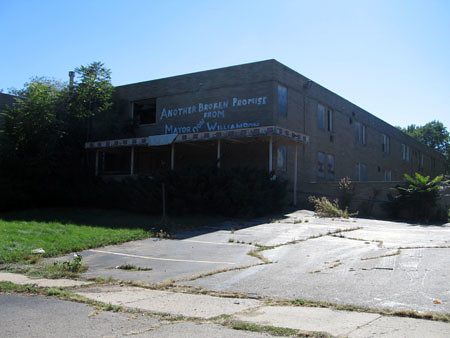
And so there is the other Flint, severed further from neighborhood development, marginalized from the new interior regeneration, enslaved to this lingering nostalgia of the auto factories one day resurrecting their jobs to them and their ancestors who have suffered the legacy of Buick for decades. He spoke about the wounded spaces of the lonely children on the street corner, in the alley, on the porch, sobbing in church or over a grave, spaces that have seen his people dwindle further and further from prosperity; the Flint that has been abandoned by its own country, and the people who have been written off to those desolate and unmapped shacks huddling there in ironic habitation.
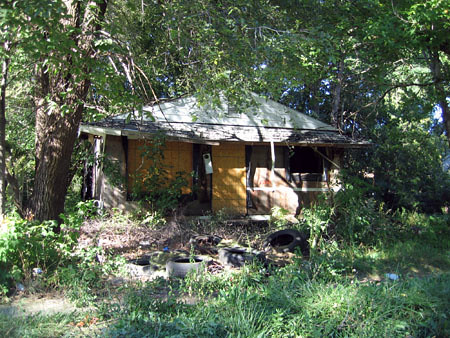
Despite all of that Brian smiled, adjusted his ball cap and offered stories about placing his hand on the hand of a man who'd already stuck the knife a small ways into his chest, just talking with him and listening to him late one night helping in those dark moments to save Flint from itself when no one else was paying attention.
Spotting someone he knew in the cafe he exchanged a short hello then quickly turned back to us and relayed a story he recently wrote for the local paper, of a black woman who had eventually found the dead body of her son in a backyard one day after he'd been missing for days and assumed to have gone so in the area. Brian then described another woman who was white and lived inside a nearby house but had been too ashamed to come outside and introduce herself much less mourn with the woman for fear that she would be judged and blamed for having not found the body sooner, being it was in her own backyard.
As Willingham told it, the mother of the lost son came there every day afterwards to be with her son’s soul and to help it flee the imprisonment of that spot in the backyard, until finally the neighbor came out after crying for a week alone to tell the mother how sorry she was for having not discovered the body earlier. And without needing to be forgiven the neighbor and mother then forged a deep healing bound and spent the following weeks building together a permanent memorial structure there in the woman's backyard in the boy’s honor. Amazing story.
It’s vignettes like that that tell you who Brian is, about the Human Spirit that refuses to die in Flint. I am reminded of another poem:
Finding The Light
The infractions of humanity upon humanity
Innocent eyes have witnessed all their lives.
Inhumane – unhuman – humanity.
In absence of human guidance,
their spirits still teach them right from wrong,
And still, they may not learn the truth
that lies within their souls until it’s gone.
Physical casualties in mental captivity.
There are the images they can’t forget,
nor can they ease them from their human experience.
Life has expressed and impressed itself upon them,
Abandoning them as they are. Where they are?
The voices of pleasure and destruction sing new songs
about old things,
Weighing themselves evilly in balanced minds,
Beating, pounding, wearing thin the spirit
and soul of young humanity,
Still unconscious bodies carry on, walking forward
but moving backward into darkness,
hoping without hope,
thinking without knowledge,
about finding the light.
- Brian Willingham, 2003
I don’t think it could have been said any better, if there is life in Flint, then certainly Brian Willingham is it. Check out his website The Soul of a Black Cop which happens to be the title of his latest book. If you ever go to Flint ring him up. He alone is reason to visit. In fact, I can think of no better prism for peering into the soul of Flint. I know I will be back there soon enough, but until then I just want to thank Brian again for taking the time out of his Saturday evening to hang out with us and share all his insight and instinct about Flint, which in my experience is what it is because of you, Brian. Thank you. (And to you too Wes for hooking it all up!)
[All pictures except those noted were taken by Bryan Finoki / 2007]







25 Comments:
Bryan,
I didn't see any information about how the remaining residents of Flint intend to feed themselves and heat their homes as Peak Oil settles in over America.
Flint is never coming back. It was founded as a fur trading post, and that option's gone, too. Hundred-dollar-a-barrel, or maybe $200, will kill what's left of the economy.
I suspect there's plenty of rainfall, which is a good thing, along with a shortish growing season and cold winters. I also suspect that most of the food coming into Flint is imported from many miles away, just like everywhere else in this country.
There's a permaculture future for Flint, if residents choose it and get to work, and a chance for some local industry, serving the locals. And if the Flintstones do it right, there will be a need for a militia to deal with the refugees from Detroit, when they come a-calling with their hats in their hands.
Eco-anarchy, anyone?
Keep up the good work, Bryan.
Thanks. Yeah, I hear ya. There are a lot of things I didn’t mention. Like the tons of garbage Canada is exporting to Detroit (I believe) for processing, maybe filtering down into Flint, eventually. Not the most glamorous economy in the world, but it’s something. Maybe it becomes the Mecca for a scrapper ecological movement.
They also have the university and I think some other schools, with strong automotive engineering backgrounds, right? maybe somehow those skills could be leveraged in another way, towards an ecological justice, convert the GM plants into something environmentally productive: machines for recycling.
It’s also just about the spirit of the community too on some level. What will those people find and reinvent for themselves?
b
Bryan,
What happens to Flint and the Flintstones depends in large part on who they're listening to and what they're reading, truisms that hold for essentially every other person and place in this benighted land.
If they listen to the TV and the "leaders," they'll end their days as disenfranchised serfs in a toxic wasteland.
If they visit such sites as www.communitysolutions.org, www.lifeaftertheoilcrash.net, subtopia ... you get the idea; kill their TVs and read a bit; and dig in, they may begin to recreate the landbase humans have enjoyed there for millenia.
Best wishes.
Hi Bryan, very interested in this post. I'm a third year student at the Manchester School of Architecture and I'm conducting research into the effects of urban sprwal and slum in East Manchester. Would very much like to quote the entire post along with pictures in a design report that I will be writing towards the end of this year. I would also be very interested to get my hands on the report report Wes produced on the topic called Deconstructing Flint. Really appreciate your help on this.
Thanks again, this stuff is brilliant!
ciaran.bodenham (at) gmail.com
Ciaran Bodenham
As a resident of Flint, this article both pissed me off for its over-the-top, decay-chíc academic ghoulishness – and made me proud of the people here like Brian Willingham (yes, there are others).
Traveling apocalyptos like this swing through Flint a couple times each year on their tours de despair - and Flint is a mandatory right of passage for all of them. They all try to 'out bleak' each other in their reports, and it's rather amusing for those of us with a sense of humor about our special brand of novelty tourism. You guys shouldn't feel too guilty though, labor historians are worse.
Though that was completely ignored here, along with anything else remotely positive other than Willingham, I always appreciate any attention this city receives - good, bad or convenient.
Thank you for coming and for your many keen, if not inflated, observations.
Still, as a writer/activist myself, I can't help think that if anyone really wants to help cities like Flint with their reporting/writing/observing/researching skills, they should move to those cities, stay and help the people there identify and work towards real solutions step-by-step. The rag we published tried to do that. I know Brian does that. May be you do that too. This is the first I've come across this site. I really do like it and will be back.
But thought you might like to see how others who live here talk about our challenges, acknowledge successes and work towards concrete improvements.
http://www.theuncommonsense.com
Happy slumming!
Someone sounds like they feel a little left out.
Whatever. Your comment is the best part of the entire post! Seriously. Hilarious. Thanks you for that.
All your points are well taken and cracked me up, too!
I am a decay-aesthetic fetishizer for sure! A gratuitous and less than sophisticated one I will be the first to admit.
Also, thanks for introducing me to the Uncommon Sense. I will check it out. And, please sling any other resources you think I should know about my way – I would really appreciate that.
And I will definitely look you up the next time I roll through Flint – if you are down.
Right on. Thanks again for coming. It's obvious you, Wes and company are on the right track and have tons of heart and talent for the battle ahead. Happy to help anyway I can. Get ahold of me through this site:
http://www.mitube.org
See you next time
Bryan, Ciaran, Anonymous, and others,
Here's the post of the "Deconstructing Flint" report I wrote for the Genesee Institute: http://www.geneseeinstitute.org/reports/index.html
Anonymous . . . like Bryan (scary thought!), I'm guilty as charged . . . eight trips to Flint in the past 1.5 years, bringing people like Bryan, graduate architecture students from Egypt, Indonesia, India, and Nepal, as well as other undergrads from Indiana and the midwest. As we approached Flint in September, Bryan asked me something like "what do you want to do in Flint?" I think I said something like, "Well, I don't know. Maybe it's not my place to do something. Right now, I'm just interested in bringing people to see it for themselves, and to meet people living in Flint." It's pretty simple for me right now . . . I don't have any other response, besides coming back and talking with people there, even as I drive into/through more and more neighborhoods, walk into a few more abandoned houses/buildings, and look for chances to get to know people who are staying, who are committed, like Brian Willingham, obviously, and Steve Jessmore, a squatter I met named Keith Austin, a private demolition contractor named Marvin Grant, and others, including a number of decent people at the Land Bank. I don't claim to know Flint, but do have an interest in the Rust Belt, the cities, people, and architectures of these shrinking cities. My home city, Indianapolis, has 8,000 abandoned houses, and I don't get the sense that very many people are paying any attention. Maybe I can help with that, maybe not.
Anonymous, you're right as well about "tours" of the despair and distress in the midwest. I led one such tour a year ago, to Detroit, Flint, Gary, Chicago, East St. Louis, and Cincinnati. Bryan Finoki helped with the editing and the posting of something I wrote about what I saw, felt, and continue to feel. Check it out at http://archinect.com/features/article.php?id=50579_0_23_0_m
Anonymous, I'll be in Flint again, maybe in November, just looking around. It'd be great to talk. Maybe at Good Beans?
By the way, Bryan, just to add a small (ironic) detail to the story, we weren't riding in any "plain white vehicle." It was a hybrid.
Wes Janz
Bryan-
I am very disappointed in you.
First, you sold out to Starbucks.
Second, you claim that there is no coffee in Indiana besides Starbucks. Au contraire, Indiana, in a slightly more noble move than California, has yet to sell out completely to 'chain' coffee stores, and I assure you that the Hoosier landscape is littered with quaint coffee shops with much more flavor (both socially and tastefully) than any "Coffee Bean" or "Seattle's Best" located on the west coast. But then again, I don't know what coffee you normally drink.
Third, you did not finish what you started in this blog. I was intrigued by this question: How do we even begin to look at such a place, or know that we are even really seeing it for what it is beyond the hollowness of its remains? I waited patiently for an answer, but never really got one. You spent a majority article writing thick, pessimistic descriptions of Flint (abandoned, dried up, urban void, urban evaporation, urban limbomania, urban death, forgotten graveyard...all very “eloquent” descriptions, BTW). While this may be true, is it really necessary?
My point is, you questioned how to see past the hollowness of Flint, yet focused an awful lot on just that. "If there is life in Flint..." then you probably have to look past the dilapidated facades and see what people are doing. It's probably difficult to see "life" in Flint when you're focused on the negative. This is not to say your observations are worthless, but they contradict what I assumed you would be talking about.
Your discussion with Brian Willingham was a step in the right direction, but fell extremely short with the suggestion that he is the "only" life in the city. I'm sure he finds this flattering, but as "Anonymous" has already pointed out, there are apparently many more like him. If in fact "seeing past the hollowness" was your intent, then you missed a huge opportunity. Something I see clearly but I don't think you ever stated was that seeing beyond the physical environment requires a person-person interaction. If Brian is a prism into the soul of Flint, how has your perspective of that 'abandoned wasteland' shifted because of that conversation, if at all? What did you learn about the psychology of urban decay in meeting Brian within that landscape? How does “Flint” in the social sense compare with “Flint” in the physical sense? What are the people of Flint really doing to move forward?
Overall, I'm surprised at the lack of critical intro and retrospection on your part, and I'm wondering if you'll be doing a follow-up piece regarding the 'deeper' issues of Flint specifically addressing the question of seeing past the 'hollowness.' It is a question worth addressing. After all, looks can be deceiving.
Otherwise, this is a good introduction to a deep and complicated issue.
Hey Kristin! How are you?
Your points are nicely stated and well taken.
While I have already and very clumsily admitted to my own tendency to stoop to the gaze and my topophiliacal lust for seeing places like Flint only for their ruinous gorgeousity, I do also think it is next to impossible to immediately see beyond the hollowness of its remains in a single fell swoop, or through a brief interaction or conversation with a single person. Let’s face it I was there for a few hours.
However, I had hoped that my encounter with Brian and the relaying of his stories about Flint’s own healing and his poetry, would make evident on its own the significance of Brian as a prism into Flint’s soul – that his character and devotion to Flint would speak for itself, that his talking someone out of suicide and his celebrations of the black and white women crossing multiple social boundaries in their mutual healing process, would reflect the interiority of Flint beyond its hollow remains and far batter than I could try to read Flint from my brief momentary interlude with it; in my mention of him I figured a lot of the pride, the toughness, the desire to be seen as something other than itself – something by the world as other than decayed Flint – (in Brian’s case as something other than just a cop but a man, a father, a son, a poet, etc), the community spirit, the downtown celebration of the antiquated car culture that is still at the heart of Flint’s culture, that ALLL of that would help capture the composite that is Flint.
Maybe in passing along these details, or in my attenuated way of expressing them, all those things seemed irrelevant to my ability to peer into Flint; to get past the hollowness of my own way of seeing.
Though, I quite agree with you about the flattened and collapsible weight of my analysis, and would agree that Flint deserves, no requires, future retrospection.
I will also say that driving through Flint in a car most of the day literally touring the dilapidated facades as we did makes it a little difficult to reach out beyond and connect in some deep meaningful way somehow. Ask yourself, how often do you do this anyway in your own hometown where you are familiar and experience that place every day? I’m not blaming Wes for chauffeuring me around all the neighborhoods I wanted to see, it’s just that I want to be honest about how much can we really expect to learn about a place this way, in a single say? Brian was great to talk to because it gave me a sense for the interior tone, from a man nonetheless who patrols the empty facades for a living.
If Brian is a prism into the soul of Flint, how has your perspective of that 'abandoned wasteland' shifted because of that conversation, if at all? What did you learn about the psychology of urban decay in meeting Brian within that landscape? How does “Flint” in the social sense compare with “Flint” in the physical sense? What are the people of Flint really doing to move forward?
I don’t think my perspective of the ‘abandoned wasteland’ has shifted but maybe only just now begun to be found, at least in Flint anyway. I had no idea what to expect, aside from Wes’s perspective and the little I knew about Flint beforehand, which wasn’t a whole hell of a lot. My first tendency though was not to write it off, as I think is the sentiment from people of all kinds who have known and identified with Flint. There is a looming opinion out there that Flint should just be demolished, the people forced to relocate and that Flint (or what’s left of it) should ultimately be re-absorbed elsewhere. But that is not my style. I am at heart an advocate for a place’s right to define itself, to survive and decide its own course of destiny (how much of that much may be in their own control, who knows). From the get-go I never abandoned Flint. I just got caught up in my own gawky fetish with decay.
In terms of the psychology of decay, via Brian (and I hope I already spoke to this earlier in my bit about Brian), I found that his disposition and sober state of mind reflected the landscape directly perhaps in how many of the abandoned structures still stood strong, solid in the ground, understated in today’s housing market but ultimately resilient; they were ruins that were too proud to totally wither away, and Brian was the solemn voice of this. Talk to him and see that he isn’t going anywhere, his soul is in Flint. Flint is a wounded landscape and I was struck by his sensitivity and compassion, his more humanly-motivated commitment than anything else to do his part to help to heal his hometown. That spoke volumes to me about the human spirit that keeps Flint going today. (He even writes a column called Human Spirit for the paper).
There is also of course the other dimensions for which he alluded to: the dark corners of madness where crime and depravity gravitate; there is the simultaneous splitting of community and a re-knitting of it as neighborhoods become more swollen with emptiness and departure; cultures are torn and simultaneously re-modeled at the same time as they undergo evaporation, demolition, rebuilding. And as much as there is the haunted layer of economic nostalgia and labor paralysis there is the constant celebration of Flint’s core identity as I experienced through the Car Show. There is strong life there, symbolizing much of what has always defined Flint and what will still go on doing so.
At one point it almost seemed real simple: if you just got enough jobs there Flint would be normal and functioning again, which made all of my missives about decay and wounding seem irrelevant. Flint doesn’t need me to cry it a river. Nor did I want to.
But, dashing through the gridded wastelands of it didn’t help me experience much else than the greater global tragedy of it all – how I said in the piece the American economy has virtually left Flint to rot as it has moved its capital to other shores. That lack of federal responsibility pissed me off when staring this place in the face and seeing a sign for a mayoral candidate who had the name Walling (as you know it is not a term I have many positive feelings for, wall wall(ing) as a verb, as a mayoral candidate! ….)
But, without ranting on too heavily I need to stop there and confess one more time, I don’t know shit about Flint, about what’s going on there, about who is doing what, about the real grassroots movement to rebuild Flint, and I certainly have even less ideas to contribute, at least for now. How could I even presume to have much to offer at this point? I guess I just wanted my experience to reflect what it was, very cleverly captured by anonymous as a ‘chic decay tour of despair.’ There are some connections I also wanted to leave up to the reader to make on their own: like Flint and New Orleans are not the far off from each other, knowing what you know about one what does that tell you about the other – about the politics of each other? I also wanted to start the piece with my obsession with death and the roadkill and end it on my intensely real sentient conversation with Brian. If I were nearby and truly curious or devoted to really engaging Flint I would I am sure make tons of connections, but that would entail as anonymous also suggests moving there.
So, while I truly value your questions and think they are genuinely right on the money I would also implore you to consider how much can we really expect to learn from such a short visit? I think the question I set myself up with cannot be so simply answered or figured in a single blog post, really. It is one I will try to unravel in every ruin I encounter – so that way Flint is the first page in my book of understanding what it means to talk about the psychic landscape of a place.
But that day, I wanted to see ruins and not as much go around and meet people, btu drive around and note the patterns of urban aging, admire the scrappers’ work, just frolic through the demented landscape poetry of modern delapidation. That was my agenda – what that was worth I will not pretend to know.
Bryan-
Your response asks the sorts of questions and shows the level of sensitivity that I feel was absent in your original post. I understand that there is little to "know" in just a few hours, and I certainly wasn't implying that you should understand more about Flint than you do.
Sometimes, acknowledging our limitations and being openly sensitive about the 'bigger picture' is enough. I think it's enough for now, in regards to Flint. Your reflections on Brian's poems, the difficulty of seeing past the facade, etc add a great deal of depth to your 'analysis' of this deserted landscape...as well as humanness, sensitivity, and respect. I think it would have been worth including these thoughts originally. Thanks.
Thanks for keeping me on my toes Kristin!
Bryan,
I want to mention another person who leads us to many others working on behalf of the people of Flint.
For the past three years, photographer/writer Steve Jessmore has crafted a photo column for The Flint Journal. According to the newspaper, "Sense of Community is Steve Jessmore's weekly photo column that highlights [the] people and things moving forward in the Flint community. Many are giving of their time, other[s] of their resources and some just unique. Each column includes a 'point of action' which gives the reader specific contact information, encouraging [him or her] to join in and help too."
For more on the column, see:
http://blog.mlive.com/flintjournal/senseofcommunity/about.html
You can find Steve's most recent photo column at: http://blog.mlive.com/flintjournal/senseofcommunity/
If you google Steve, you'll find the following: "Steve Jessmore has won numerous state and national photojournalism awards including the Robert F. Kennedy photojournalism award for outstanding coverage of the disadvantaged."
Fact is, I drove up to Flint from Ann Arbor one Sunday morning in late 2005 to meet and talk with Steve and that's when I met Brian Willingham, at the Brown Sugar coffee shop in downtown Flint. And I think a photo in your posting about Flint -- of Brian Willingham sitting on the floor reading to children -- was taken by Steve for a Sense of Community column.
Next time we're in Flint, we'll talk with Steve.
Wes.
Bryan,
I've spent most of my life in Michigan -- I grew up in the 'poverty belt' of central Michigan, though in the relative cosmopolis of Mt. Pleasant. For the last 10+ years I've been mostly based in Ann Arbor, though now when I'm in the US I stay in Ferndale (just north of the infamous 8 Mile).
As I'm sure you know, Flint is barely remarkable within Michigan these days. I wonder if you have encountered any information on how Flint's role has changed in the geographical imagination of the state. This would direct us to see ways that specific cities become indexes of our social well-being more generally: there was a time that Flint's difficulty seemed to be special within Michigan -- or a result of Detroit-contagion (an interesting idea in itself, and surely centering on race). Now it seems to have been a precursor, an early sign of what was coming for us all. But it is also seen much more negatively in national representations than in local representations, though true in N. Michigan I believe it is often dismissed as part of the tragedy of SE Michigan.
This also relates to something you said in a comment -- “how often do you do this anyway in your own hometown where you are familiar and experience that place every day.” I think the question about habituation really directs us to something important about decay, at least in Michigan. Sometimes decay is decay, and in other places/contexts/moments, it's not. I'm thinking about how decay is a kind of markedness that is partly due to the expectations of the observer, but also shaped by other contextual features -- history, visual environment, style of interaction, expectations for the future etc.
For example, I was struck by how much the images you posted looked to me like they could be anywhere in central Michigan. But I don't think of that as decaying -- it never had much money in the first place! It's just how people live. Something works for a while, some business functions, and then it doesn't, and who has the money to do something else with it? It gets left there, but so what? It takes a photography major at a local college to notice it. It seems important to me to understand the specific histories that make a place with falling-down buildings decay in a social sense -- and how histories of representation are a part of that. I think it also relates to how individuals/groups are habituated to living in spaces like Flint. It really makes me want to see comparative images from the small towns around Flint, from other Michigan cities, and other midwestern cities. There is a great deal of continuity between rural and urban spaces in Michigan, perhaps thanks especially to the flat open spaces characteristic of both Detroit, Grand Rapids, and the central plains. I feel like that's important here.
Also, thinking about these connections, I'm wondering about the category of urban decay generally. Being so attuned to Michigan's small towns myself, I want to know how Flint's loss of jobs has played a role in visual/architectural changes in the surrounding small towns.
Another reason I'm thinking about this is that I'm staying in India now for dissertation research, based on the east coast in the city of Bhubaneswar, in one of the infamously poorest states of Orissa. What's remarkable to me coming from Michigan is how, here, there are signs of decay everywhere, but people talk only of progress. There is so much hope here! People here don't see their place dimly, as it seems the folks at home do, yet this is the poor end of the so-called third world. I guess I'm looking for ways to understand this, and thinking about the sociality of decay seems to be one rich starting point.
Thanks for such an interesting post -- and such a rich blog! I'm looking forward to reading the rest of it over my holiday break.
Katherine
Hello, I live in Flint, next to highly rated Kettering University, about fifteen minutes from an airport with direct flights to NYC, ten minutes from the Flint Symphony Orchestra and one of the best little industrial museums I've ever seen--the Sloan, not to mention the Flint Institue of Arts. I spend about a fifth of my take-home pay on one of those "low-quality" houses you wrote about--Built by General Motors in 1927 it is as solid as a rock, has more old growth Michigan oak in it than any new McMansion could afford, I can continue my University of Michigan (Ann Arbor) education at the Flint branch, again ten minutes away. Besides two universities, there are also two major hospitals providing jobs within the city limits. What your Flint experience will be depends on the qualifications you bring to the city. I brought a graduate degree, marketable skills, urban living experience, and thus no fear of the city. Others could do the same. Your post is EXTREMELY DISTORTED and would deter others. Not a service to Flint.
Hey I'm from Grand Rapids. Is there a high amount of churches near the liquor stores? I swear they grow in near equal proportion.
I am a Flint resident, have been all my life and it is getting real bad here real fast. Even worse than it was. 4 years ago my modest house was worth $100,000 grand, now after over $50,000 in renovations it's only worth $35,000 because no one wants to come here. In a one square mile block around my home in Mt Morris Township there are at least 75 houses for sale and half of them are boarded up. That's just the main roads, not even counting all the side roads. I should have listened to my southern husband when he wanted to sell and go south 4 years ago.
I was born in Flint and think most people who live outside of Flint have no clue. Yea it's violent (in areas), dirty (in areas), and depressing (in areas) but it has nothing on Detroit or St. Louis (statistically worse cities to live in) and even parts of Saginaw are far worse than Flint. In recent years people have actually moved back in to neighborhoods such as Mott park and especially Woodlawn Park. Several of the "older" neighborhoods along Miller road near the School for the deaf are also strong and safe. The problem with Flint is no one over the age of 40 wants to make a serious effort to turn things around, or elect people who care. Our last two mayors have both been crooked and anything that would promote the return of youth or "enlightened" people to downtown (i.e. The Flint Local 432, and Red Ink Studios) draw little local support from "old " people who are scared to come downtown thanks to articles like this and heavily skewed movies like "Roger and Me". Not everyone in Flint is losing their homes and most of the people who are I don't feel sorry for. Most of the housing turn over is due to plane old financial stupidity and is a national epidemic not just a Flint problem. Apparently the death of GM isn't giving the University of Michigan cold feet seeing they just dumped money into more student housing. Seriously your pictures show the bad parts of Flint but I don't doubt that you could have that affect on any town if you did the research and knew where to look. Why don't you go check out Gary Indiana, or "Smoketown" in Louisville, KY? I know my statements are getting pretty unorganized but my reaction is becoming more visceral.
Brian-
Yeah, I would never go downtown Flint because it is too dangerous. The police found a body in the river next to Red Ink Studios. That's a terrible part of town. Gunshots can be heard throughout the night and all the lights are turned off. Past 8pm downtown looks an abandoned warzone with empty buildings everywhere and people on crack and other drugs are roaming the streets and breaking into houses.
I find it interesting that someone leaves a message about how he's not focusing on the good parts of town and then the next comment is talking about why they won't go downtown. I'm a veteran of the Distress tour and know how much actually visiting the downtown affected me. I never really gave a damn about the hood. I just knew it was bad and the people there struggled to make it. My views changed to wanting to help after visiting. Maybe I'll never help Flint, Detroit, East St. Louis, or Chicago, but maybe they helped me. I now have a new sensitivity to redevelopment ideas. How would me moving to Flint help? I'm just going to be sitting on the porch of a vacant building (cause I can't afford to buy a house even in Flint) with scavenged (technically stolen) materials that managed to round up to hold most of the rain out or maybe even block some wind hoping that the cops don't come kick me out. I can march the streets trying to round up people to help me rebuild the neighborhood, but I doubt any of them want to join an outsider with no way of helping them other than donating some time. I'll have plenty of that since I won't be able to get a job (don't want me stealing one from an existing resident). I wonder how long it will be before I get shot and end up next to the Red Ink Studio for being on the wrong person's turf. I have a better chance at making a difference from here having simply visited and doing write ups on my ideas for helping the situation and sharing it with decision makers that have the ability to effect real change. I have a better change of encouraging a business to stay in the inner city and reinvest in their business because they are making a bigger difference than the little money they are making attests to. I don't know what I can do, but I can't do it without seeing the reality of the situation and sharing that with others. Who knows who's going to read this blog and see what he was saying and realize they have the ability to help that situation.
amazingly all the photos in this blog are familiar to me,i do not even live here but i've seen most of these places with my own eyes and it doesn't even come close to the scope of the situation, this by far is the most desparate place i've ever done demographics on, it seems like everyone here is strung out on herion and loaded with crack, what a waste of human life, these people in this city might just as well die of starvation, it would suit michigan well, do us a favor and just set fire to the whole place and plow the dirt back to corn fields and feed the rest of the michigan residents, my experience in flint has been the worst you could ever imagine, don't trust anyone, they would rather screw you than help you, the union has ruined not only flint but the whole state of michigan for their own selfish needs, what do you think would happen when you overpay uneducated idiots to assemble automobiles, i hope they got what they wanted for a minute because they'll pay for it for a lifetime, don't leave your belongings unnattended for too long and lock it down with locks, alarms, video, shotguns and whatever else you can think of and chances are they will still make off with it, border to border scumbags (the whole city) if you need job security go to flint and become a police officer you will eat for a lifetime, real estate investors (like myself) BEWARE bad idea, real bad idea, the vacancy ratio is huge here but on the lighter side most of the homes are not even rebuildable, but that doesn't matter because no one here has any money and you won't get your rent money anyways, don't think about flipping, banks don't loan on these dumps, good luck
Ok one lets now concentrate on one part of flint with all the abandoned house's . Read the stroy here read the comments. Starbucks? Brown Sugar Cafe? Yeah flint is a lot bigger than that one little concentrated area near downtown. To anonymous no most of the food is not transported from miles away the majority is local. GM is down but not out.And just so everyone knows you act like oh well if GM dies then flint will follow hello if GM dies with the rest of these 3 automakers well you will see this entire country in depression not just flint,mi. The problem here is the same as every where else money money money,corruption in local and federal government. But lets all rest assured we all gonna die in 2012 anyways so who gives a flying fuck . hahaha
P.S. BSU boys stay in ohio and write shit about your own city's instead of coming to my hometown and writing and harping on our hardships and cracking your half ass jokes
What's more interesting to me is that nearly every city or town in the US where I have visited or lived has sections that look very similar. The exception was NYC (lived in Brooklyn) where density is the norm and land is valued.
It is easy to understand the build elsewhere rather than fix mentality when you compare our land mass to other countries. However as economies change, maybe we can adopt a fix rather than build new elsewhere model. I still think the market forces that create wastelands can turn around and fix them. Until then, most just drive by on their way to the "new" mall or suburb and don't notice the decay.
Also from Flint (born there, but the parents moved us out to the suburbs - to Grand Blanc, where you probably found that Starbucks - when I was in elementary school). Don't have much to add to the conversation, because others have already spoken eloquently on the subject, but I did want to point out that the fact that "you only spent a few hours there" is not an excuse, it's actually a big problem (one that seems to plague journalistic and academicizing blogs). How can you expect to offer anything worthwhile to the dialog if you just drive around taking pictures of what you came to Flint expecting to see? Unless you really immerse yourself in the subject - learning about the history and meeting more people - you're just going to regurgitate stereotypes, and perpetuate the the prejudices you arrived with, which contribute to the alienation of cities like this. What's more interesting - and less thoroughly documented - than the "gorgeosity" of Flint's urban decay is the fact that more than a hundred thousand people still somehow eke out a living there. You'd learn more about the changing economy and contemporary American society if you looked harder at how people in the city live than by driving around rhapsodizing about the city's "death."
If it is decay, let it be......
time will sew into the soil seed
when time goes by seed will sprout
and when it sprouts life
people will stop and stare
beauty of future life
remains and regrowth from past
If it is decay, let it be......
city of Flint resident -Christina-
Post a Comment
<< Home